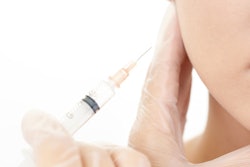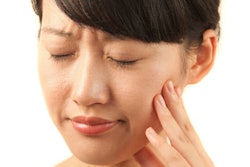
Up to 10% of your adult patients may have pain from temporomandibular disorders (TMDs), including refractory masticatory muscle pain. If conservative therapies are not effective, is botulinum toxin type A (Botox-A) an option?
It is, according to a new study in the Journal of Oral and Maxillofacial Surgery (November 2017, Vol. 75:11, pp. 2307-2315). Researchers from Boston found that 30% of patients using Botox-A found significant relief of their pain symptoms for a mean period of more than 10 weeks.
"General dentists that are managing patients with TMDs can use Botox-A for management of masticatory muscle pain-associated symptoms," lead study author Shehryar Khawaja, BDS, wrote to DrBicuspid.com. "As shown in our study, sometimes pain associated with TMD does not respond to conventional modalities, such as physical therapy, pharmacotherapy, or dental orthotic devices. In such cases, this can prove to be a very beneficial tool to have in their armamentarium."
Dr. Khawaja is now affiliated with the department of surgical oncology at the Shaukat Khanum Memorial Cancer Hospital and Research Centre in Lahore, Pakistan. At the time of the study, he was a resident in the division of oral and maxillofacial pain in the department of oral and maxillofacial surgery at Massachusetts General Hospital in Boston.
Uncontrollable pain
Temporomandibular disorders are a subgroup of craniofacial musculoskeletal and neuromuscular disorders that involve the temporomandibular joints, the masticatory muscles, and associated head and neck tissues. Between 2.5% and 10% of U.S. adults have these disorders, according to previous studies.
Masticatory muscle disorders in TMDs often include persistent, recurring chronic pain and a limited range of mandibular motion. While the pathophysiology of these disorders is not entirely understood, previous studies have identified risk factors such as being female, pain during jaw functional activities and palpation, presence of other pain conditions, and others.
“If a patient has no relief in symptoms, or if conventional therapy is contraindicated for some reason, Botox can be tried.”
While TMDs often respond well to conservative therapy, the pain does not resolve for some patients and becomes refractory, meaning it is unable to be controlled despite best efforts. This is when botulinum toxin type A has been used. This treatment has been shown to be effective in the management of other chronic pain disorders, but there are conflicting results on its effectiveness in patients with masticatory muscle disorders.
The researchers of the current study sought to determine the efficacy and safety of Botox-A in refractory masticatory muscle pain and also identify demographic, diagnostic, and therapeutic characteristics that would predict the clinical outcome of Botox-A therapy.
They performed a retrospective chart review of 116 patients who underwent at least two injection cycles of 100 units of Botox-A with 12 weeks between cycles for refractory masticatory myalgia at the Massachusetts General Hospital Department of Oral and Maxillofacial Surgery between May 2012 and June 2016. The majority of these patients had experienced this pain for more than five years.
Why two cycles? This allowed time to determine the safety and effectiveness of the treatment, according to the study authors. The first dosage may not show the full physiological response to the injection therapy, and it may take between two and six months for effects to become known, they noted.
More than 30% of patients reported significant pain relief for a mean period of just over 10 weeks. Moderate relief was reported by almost 40% of the patients for almost nine weeks, whereas 29.6% of participants had no or minimal relief for less than 1.5 weeks.
"Significant relief was defined as a patient reporting at least 75% relief in pain score, and minimal or no relief was defined as less than 25% relief in pain symptoms after undergoing injection therapy," Dr. Khawaja wrote.
More than 16% of participants reported at least one adverse effect during the course of the injection cycles. Surprisingly, the group experiencing significant relief of symptoms reported the greatest number of adverse effects (30.3%). The most common side effect reported was a reduction in the size of the masticatory muscle.
The researchers found the effectiveness of Botox-A therapy to be statistically associated with the presence of muscle hypertrophy (p = 0.004), range of motion (p = 0.02), concurrent use of opioid analgesics (p = 0.003), and local anesthetic injections (p = 0.003). The presence of muscle hypertrophy and occurrence of adverse effects were predictors of positive outcome, while concurrent opioid use was a predictor for no or minimal pain relief, the study authors noted.
Not first-line therapy
For study limitations, the authors acknowledged that their study was a retrospective analysis, so they were not able to account for all factors involved in the research. However, they did point to the novelty of their research.
"This is the first study to our knowledge that has evaluated efficacy, safety, and predictors of the clinical outcome of Botox-A therapy in refractory masticatory muscle pain," the authors wrote. "Nevertheless, these results need to be interpreted with caution and necessitate replication."
Dr. Khawaja noted that conventional therapy is preferred as a first-line therapy because of the relatively high cost and lack of insurance coverage of Botox-A.
"Patients should be offered conventional modalities that are much more cost-effective," he wrote. "However, if a patient has no relief in symptoms, or if conventional therapy is contraindicated for some reason, Botox can be tried."
In addition, he noted that based on his recent experience, insurance companies have become more flexible in providing coverage for Botox for management of masticatory disorders.
"[This] is good news for patients and practitioners," he concluded.



















